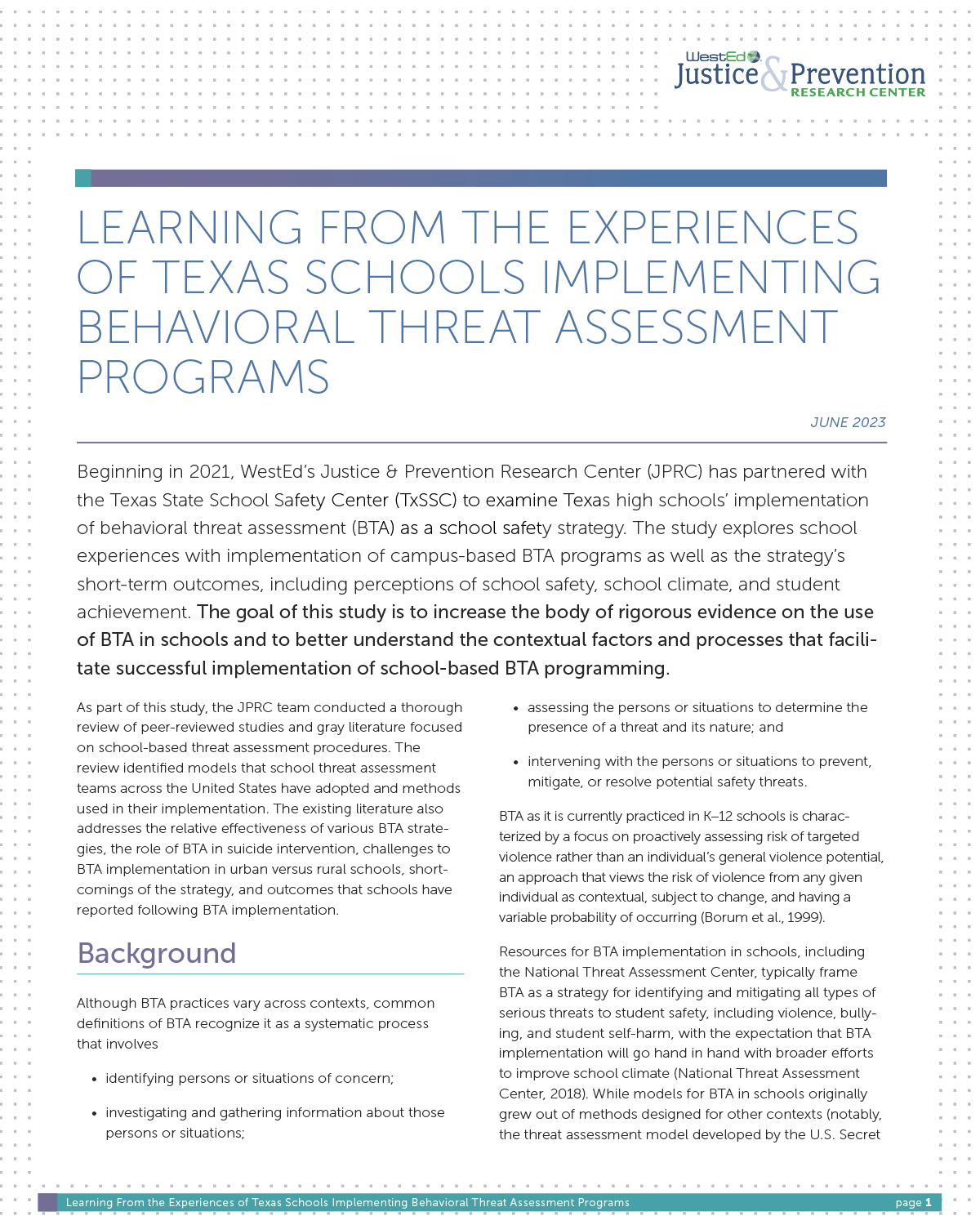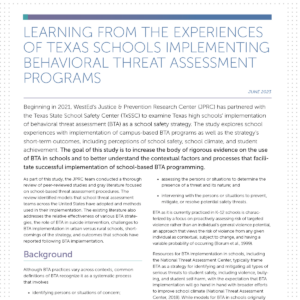Implementing Behavioral Threat Assessment Programs to Improve School Safety
Posted on

By Trent Baskerville and Alexis Stern of the WestEd Justice & Prevention Research Center (JPRC). The JPRC collaborates with partners in funding, implementing, and evaluating programs that promote positive youth development; physical health and well-being; and prevention of risk behaviors, including violence. The full team for this project includes Trevor Fronius, the project director, as well as Sarah Guckenburg and Justine Zimiles.
School-based behavioral threat assessment (BTA) is a school safety strategy focused on identifying and mitigating threats to the school community, such as violence, bullying, and student self-harm (National Threat Assessment Center, 2018). Common definitions of BTA recognize it as a systematic process involving four key steps (Borum et al., 1999):
- Identifying persons or situations of concern
- Investigating and gathering information about those persons or situations
- Assessing the persons or situations to determine the presence of a threat and its nature
- Intervening in the persons or situations to prevent, mitigate, or resolve potential safety threats
The JPRC is working with the Texas School Safety Center (TxSSC) on a study that examines Texas high schools’ implementation of BTA programs to improve school safety. The study, funded by the National Institutes of Justice (NIJ), aims to increase the body of rigorous evidence on the use of BTA in schools and to improve understanding of the contextual factors and processes that facilitate the successful implementation of school-based BTA programming. The study includes an examination of the student outcome of the BTA model and a multisite case study.
Texas is one of several states that mandates the use of BTA in schools (Texas Education Code § 37.115, 2019). Specifically, to reduce the number of targeted threats to school safety, Texas school districts must adopt policies, procedures, and training as part of implementing a “safe and supportive school program,” and districts must ensure that there is a team to implement the program—including BTA—for each campus.
This blog post, which follows a previous post summarizing the literature on school-based BTA, explores what the JPRC research team has learned through surveys, interviews, and focus groups with staff at 186 public high schools in Texas over the last 2 years. Findings from the implementation study are summarized in greater detail in the full report.
Qualitative analysis of data shared by school staff through the surveys, interviews, and focus groups reveals a complex picture of BTA implementation in Texas high schools. More than 95 percent of school staff who completed the second survey reported that their schools had BTA teams in place. Interview and focus group participants were asked to discuss challenges and successes that they have experienced in the course of developing their schools’ BTA programs. Although these participants described barriers and obstacles that they have navigated in their implementation of the BTA model at their school campuses, they also identified numerous strengths of their BTA programs, schools, and communities that have supported the establishment of effective BTA teams and processes.
Our Methods and Approach
In partnership with the Texas School Safety Center, JPRC researchers conducted a baseline survey in the fall of 2021 to capture information about BTA training completed by school staff and implementation of BTA programs in Texas public high schools two years after the passage of the legislative mandate. Of the 111 schools that responded to this initial survey, 37 staff from sixteen school sites participated in follow-up interviews and focus groups in which they provided additional details about their BTA teams, process, and implementation experiences. A second survey, conducted in the fall of 2022, captured information from 59 schools about their ongoing implementation of BTA and how their BTA programs have changed over time.
School and Community Engagement Supports Successful Implementation
Most BTA team members at the schools in this study received similar training and information about school-based BTA, but the data show that this information is being interpreted and applied differently by different districts and campuses around the state. School and community inputs are particularly important in guiding how BTA is implemented in schools.
Availability of school and community resources emerged as a key factor in the implementation of schools’ BTA teams. Adequate staff time, in particular, was identified as an asset and fundamental necessity for the BTA process, along with access to supportive in-school and community-based services for students. However, multiple participants in the interviews and focus groups reported that it has been difficult to find the time for staff at their schools to participate in BTA team meetings.
In the follow-up survey, 46 percent of respondents identified limited staff time as the top challenge that they faced. Similarly, some interview and focus group participants reported that it has been a challenge to connect students with mental and behavioral health resources in areas where they are limited.
Less tangibly, interview and focus group participants also discussed what they perceived as the effects of school culture and community buy-in on the success of their BTA teams and processes. For example, some participants highlighted buy-in by school and district leadership as critical for ensuring that their BTA teams had the resources—including staff time—that they needed to operate.
Participants also discussed the importance of parent buy-in in the threat assessment process, describing how valuable it is when parents are invested in obtaining appropriate support for their children and how challenging it can be when parents do not participate fully in the process.
Other participants credited a positive school culture, a transparent approach to communication with the school community, and relationships of trust between students and teachers with their schools’ ability to ensure that a BTA team is made aware of potential threats.
Developing Case Studies and Sharing Lessons Learned
In the coming months, JPRC researchers will continue to collect and analyze data from school administrators, teachers, counselors, and other professionals involved in the implementation of BTA programs at Texas high schools. These data will be used to develop case studies and synthesize lessons learned from Texas schools and districts with established BTA programs. One area of interest that the team will explore is how such schools have overcome common implementation challenges that schools encounter in the course of this work.
Based on data collected so far, possible strategies may include efforts to
- Engage parents, students, and other community interest holders in the BTA process through education and awareness campaigns and
- Develop clear, school-specific protocols, procedures, and guidelines to ensure consistency in threat assessment and information sharing practices.
These and other practical insights may be valuable to others who are considering or beginning the process of implementing BTA in their own schools, districts, or regions—including state and federal legislators, school- and district-based educators and support staff, mental health professionals, students, and families.
 For a deeper look at this study’s findings regarding the implementation of BTA in Texas high schools, please see the full article.
For a deeper look at this study’s findings regarding the implementation of BTA in Texas high schools, please see the full article.
This research project receives support from the U.S. Department of Justice, National Institute of Justice (Award 2020-MU-MU-0011). This presentation solely reflects the views of the research team at WestEd.
Trent J. Baskerville is a Research Assistant at WestEd’s Justice & Prevention Research Center (JPRC). In this role, he focuses on data collection, qualitative analysis, community outreach, technical assistance, and information synthesis in areas of the justice system, reentry, violence prevention, and mental health.
Alexis Stern is a Research Associate in WestEd’s Justice & Prevention Research Center (JPRC). She contributes to research and evaluation projects in areas including juvenile justice, school safety, school climate, and public health.
References
Borum, R., Fein, R., Vossekuil, B., & Berglund, J. (1999). Threat assessment: Defining an approach for evaluating risk of targeted violence. Behavioral Sciences & the Law, 17(3), 323–337.
National Threat Assessment Center. (2018). Enhancing school safety using a threat assessment model: An operational guide for preventing targeted school violence. U.S. Secret Service, Department of Homeland Security. https://www.secretservice.gov/sites/default/files/reports/2020-10/USSS_NTAC_Enhancing_School_Safety_Guide.pdf


